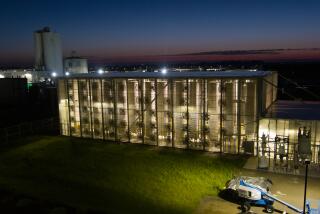Experts Find No Quick Fix for Atmosphere : Environment: The problems of global warming and ozone depletion are too big to engineer a solution, they say.
SAN FRANCISCO — Scientists who have been looking for a way to reverse the damage humans have unleashed upon the Earth’s atmosphere offered a disconcerting opinion Monday: There probably is no solution other than to mend our ways and hope the planet heals itself.
There is substantial evidence that the Earth is growing warmer, due chiefly to the burning of fossil fuels, and the layer of ozone that protects the planet from harmful solar radiation is thinning because of the use of refrigerants known as chlorofluorocarbons. Both changes in the atmosphere have resulted from human habitation of the planet, and both threaten life as we know it.
Thus scientists are frequently asked what they can do to reverse the trend. Experts gathered from across the country this week to ponder that question during the winter meeting of the American Geophysical Society.
The collective answer? Not much.
Scores of solutions have been proposed, ranging from pumping chemicals into the upper atmosphere to fertilizing the ocean, but key scientists have concluded that none will work.
“Nothing proposed yet is even remotely feasible,” said F. Sherwood Rowland of UC Irvine, the scientist well known for foreseeing the ozone problem. Furthermore, he said, no engineering solution is likely to work because the scale of the problem is too great.
Rowland said he is most often asked why scientists do not develop a way to manufacture more ozone and ship it to the upper atmosphere to replace the ozone that is being destroyed by the chlorofluorocarbons. That is not possible, he said, because of the scale of the problem.
It would take more than twice the energy now used by all humans to produce the necessary amount of ozone, Rowland said. Then the gas would have to be delivered repeatedly to the Earth’s upper atmosphere in prodigious quantities and nobody has figured out how to do that, he added.
The message in all of this, a panel of scientists concluded, is that there will be no quick fix; there is no engineering solution to the degradation of the Earth’s atmosphere resulting from human activities. The only answer, they said, is to reduce reliance on fossil fuels, which release carbon dioxide into the atmosphere in the first step of the greenhouse effect, and to eliminate the use of refrigerants that destroy the ozone layer.
It is not, however, as if scientists have not been looking. They have examined a wide range of suggestions, and some who have proposed possible solutions were on hand to announce that they had concluded that even their own ideas will not work.
So little is known about how the atmosphere is changing that any attempt to fix it may worsen the problem.
“We don’t understand how we are changing the climate now” through the use of polluting chemicals, said James Hansen of the National Aeronautics and Space Administration’s Goddard Institute for Space Studies in New York. So to try to solve the problem by engineering changes “may cause more problems than we solve,” he said.
The solutions that have been proposed were branded by Rowland as “science fiction.”
Ralph Cicerone and Scott Elliott of UC Irvine and Richard Turco of UCLA suggested recently that the global warming crisis might be eased if gases that would protect the ozone could be released by high-flying aircraft. But Turco said Monday that the proposal was meant to illustrate that such a plan is not feasible. It would mean, for example, the end of blue skies. And the air would stink.
He said the scheme was proposed to demonstrate the problem of scientists proposing solutions that cannot possibly work. “It is the problem of incredible reports coming from credible people,” Turco said.
Some areas under study are scientifically interesting but also not realistic, other scientists said. John Martin of San Jose State University’s Moss Landing Marine Laboratory once quipped to a friend during a scientific gathering that if the ocean could be made more fertile, it would produce more organisms that would pull carbon dioxide out of the atmosphere, thus reducing global warming.
That has led to plans to try out the theory by adding fertilizer--iron--to the sea, somewhere in a test area in the Pacific, to see if biological activity can be increased. The experiment is intriguing from a scientific perspective because it could illuminate the ocean-atmosphere interaction, but it is not going to end global warming, said J. L. Sarmiento of Princeton University, who is working on the experiment.
Even if it pulls carbon dioxide out of the atmosphere, it will release at least two other greenhouse gases, and if applied on a global scale it could cause severe environmental damage, he said.
Other ideas include blasting dust particles into the upper atmosphere to shade the Earth, but no one is quite sure how to do that or even whether it would be wise. Others have suggested sending up giant balloons to create an umbrella of sorts, thus bringing temperatures down slightly, but that idea is also fraught with problems.
Rowland said there seems to be no end to proposed solutions, and some of them come from scientists who ought to know better. He and his colleagues expressed concern that people are living under the misconception that somehow, when the problems become urgent, scientists will come up with an overnight solution.
But that is not going to happen, he said.






